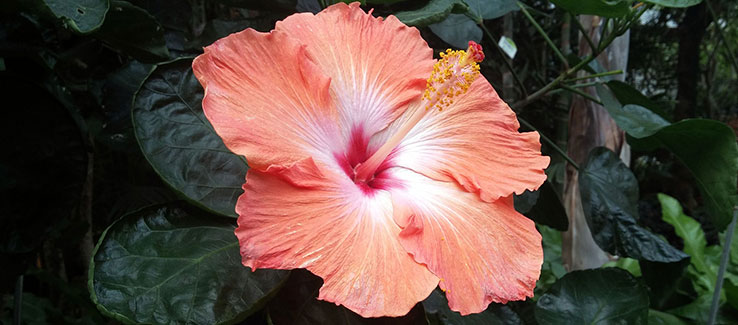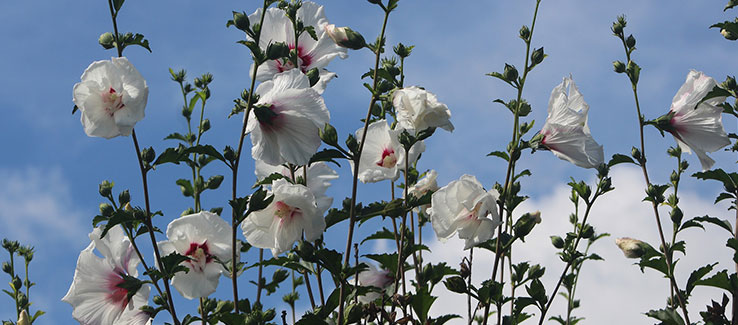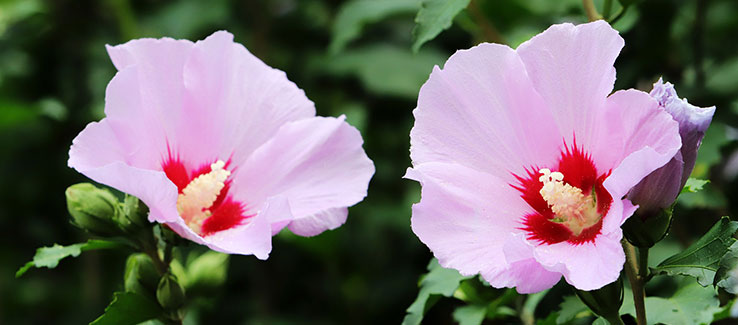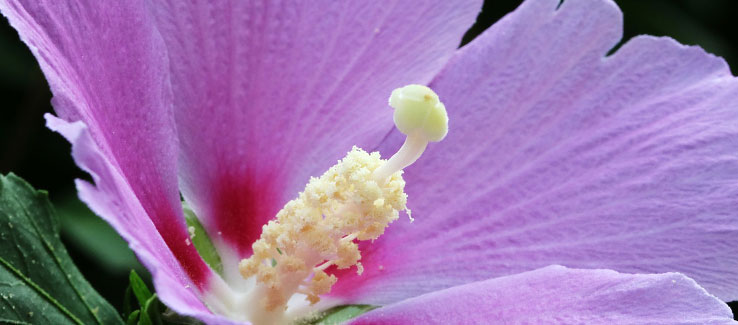Planting, Growing, and Caring for Hardy Giant Hibiscus (Rose of Sharon)
You can plant, grow, and care for hardy giant hibiscus with ease. This fast-growing species is easy to plant and grow as a privacy screen, large shrub, or small tree.
fasttreeremovalatlanta.com gathered the following information on the hardy giant hibiscus species, planting, growing, and care tips, and its susceptibility to insects and diseases.
Hardy Giant Hibiscus Planting and Maintenance
This shrub could easily be considered one of the easiest to plant and maintain. The species is tolerant of a variety of soils and pH levels. When planting a giant hibiscus, use the following as a guide:
• Plant during early spring or fall
• Species can be planted in full sun or partial shade garden spots, groupings, or inline as hedges/screens
• The species can handle areas with constant or strong wind
• Plant in well-drained sandy, loam, or clay soil
• The hole should be as deep as the root ball and three times as wide
• Add compost and mulch immediately after planting
• Water regularly, increasing the number of waterings during periods of drought
The following will help you keep your specimen growing healthy:
• Add compost and mulch each spring
• Prune only in late winter or early spring (before new growth emerges)
• Cut back old, weak, or dead branches (encourages new growth and larger flowers)
• Continue a regular watering schedule with increased intervals when rainfall is below one-inch per week.

Hardy Giant Hibiscus Species Information
Tree Name – Rose of Sharon (aka Giant Hibiscus or Shrub Althea)
Scientific Name/Species – Hibiscus syriacus
Family – Malvaceae
Genus – Hibiscus
Nickname(s) – Korean rose (South Korea), Rose of Sharon (North America), Syrian Ketmia, Shrub Althea, and Rose Mallow (in the UK).
National Flower – South Korea.
Hibiscus in History – This species is mentioned in the Bible’s Song of Solomon (2:1-2)
Lifespan – Can live up to 50 years or more when planted in optimal conditions.
Type – Deciduous.
Hardiness Zone(s) – from zone 5b to zone 9a
Soil Requirements – Prefers well-drained, slightly acidic to acidic, moist, rich, and fertile soil with full sun exposure.
Planting Spacing – 2 to 3ft apart to create a hedge.
Watering Requirements – Regular when young or planted. Minimal after that.

Height – 8 to 12ft on average
DBH – Grows multiple trunks unless pruned to create a single-trunked specimen tree.
Crown Span – 6 to 10ft or more at maturity.
Root Spread – Located just below the soil and may spread far beyond the tree’s canopy.
Uses in Landscaping – Rose of Sharon can be planted as a tall hedge/screen, pruned to be a single-trunked specimen tree, or planted as a garden border.
Winter/Fall Colors – Yellow before leaf-drop in the fall.
Flowers – Mature, healthy specimens can bloom continuously from late spring through early fall. Its five-petaled bell-shaped flowers (up to three inches in diameter) in white, red, purple, violet, mauve, or blue, or in dual colors with a different colored throat, depending on the cultivar. Extending from the base of the flower’s five petals is a pistil at the center, with the stamen around it.
If you’re looking for other colorful plants, check out these blooming shrubs – fasttreeremovalatlanta.com/5-blooming-shrubs-landscape-garden
Hardy Giant Hibiscus Pest and Disease Problems
The Hibiscus syriacus species have problems with very few pests or diseases, they are vigorous and highly resistant when planted in optimal conditions. The pests that can pose a problem are:
• Japanese Beetles
• Spider Mites
• Aphids
• Whiteflies
Some of the diseases that may attack the species include:
• Powdery Mildew
• Cankers
• Blight
• Gray Mold
• Leaf Spots
These pests and diseases can be treated with commercially available sprays and dusts. However, the following will help prevent contamination and spreading of pathogens:
• Planting disease- and pest-resistant species
• Avoiding overhead watering
• Allowing sufficient air circulation around and through the plant
• Deadheading spent flowers (removing them)
• Removing dead, infested, or diseased plant material
Read more about disease prevention for trees and shrubs at fasttreeremovalatlanta.com/5-tree-shrub-disease-prevention-tips
Note: Upon the detection or suspicion of any beetle infestation, it is highly recommended to call a professional tree service to evaluate the situation and recommend a swift course of action.

Hardy Giant Hibiscus
In this article, you discovered information about the hardy giant hibiscus (rose of Sharon) species, how to plant and care for it, and the insects and diseases that adversely affect it.
By correctly planting and caring for your giant Hibiscus plants, you are providing the species with what it needs to flourish for decades.
By ignoring or overlooking signs of infestation or disease, you may allow insects and disease to weaken the health of your Rose of Sharon, and eventually kill them.
Sources:
arborday.org/trees/treeGuide/TreeDetail.cfm?ItemID=915
hort.ufl.edu/trees/HIBSYRA.pdf
plants.ces.ncsu.edu/plants/hibiscus-syriacus/
(404) 220-9965
(404) 220-9963

